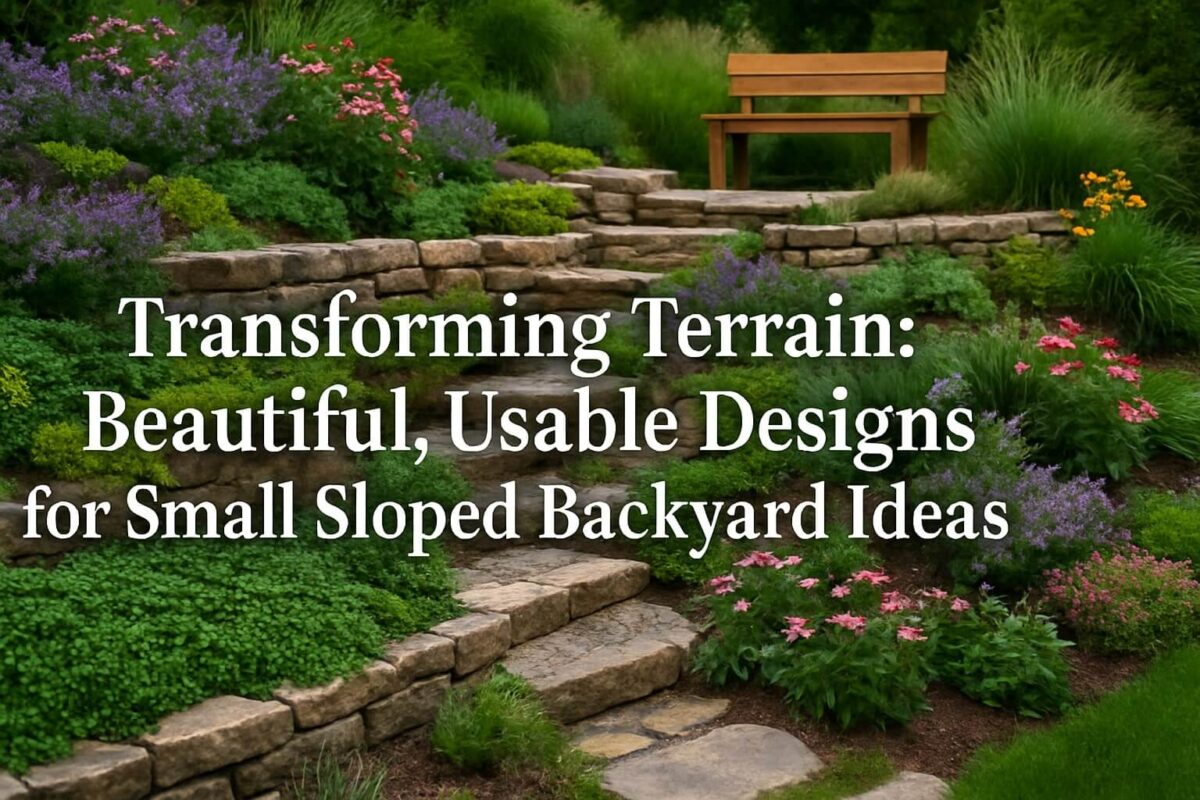There’s a special kind of charm to a yard that doesn’t sit perfectly flat. While a sloped garden might seem like a landscaping headache at first glance, it actually invites one of the most creative playgrounds in outdoor design. Especially in small spaces, slopes add dimension, drama and opportunity for unique layers of living. From cascading flower beds to timber terraces tucked into gentle inclines, small sloped backyard ideas are proof that character often comes with a tilt.
Let’s face it, flat gardens are easy, but they rarely surprise. A slope gives you structure, a sense of elevation, and even the chance to turn a narrow yard into something far more visually engaging. The trick is knowing how to tame that terrain while keeping costs, runoff, and maintenance in check. Whether you’re working with a shallow gradient or a steeper hillside squeezed behind a bungalow, there are ways to shape it into something magical without blowing the budget.
Start with water and flow. In any sloped garden, the first concern should be where the water wants to go. Even modest inclines can create mini streams during a summer storm. That’s why successful designs begin with good drainage. A simple gravel trench or a hidden French drain, tucked along the edge of a patio or pathway, can quietly channel water without disrupting the aesthetic. Some gardeners even lean into the flow and build small rain gardens partway down the hill, planting moisture-loving natives like swamp milkweed and switchgrass to help filter and slow runoff.
Once the drainage is sorted, structure becomes your best friend. Terracing is a classic move, especially in small spaces. But instead of thinking about massive retaining walls, scale everything down. Think of terraces as garden steps or planting shelves. Stone risers just a foot high, with flower beds spilling over the edge, are often all that’s needed to make a slope both safe and lovely. Modular concrete blocks, timber sleepers, or even stacked boulders can become low retaining edges that double as built-in seats.
Gabions are another clever idea in compact sloped backyards. These are wire mesh cages filled with rock, used as retaining walls, benches or planters. They’re modern-looking, durable, and DIY-friendly if you’re up for a bit of heavy lifting. Top them with wooden caps and suddenly your hillside has a ready-made place to sit with a coffee and take in the view.
Planting plays a big role too, especially when you want to keep things low maintenance. Groundcovers are the heroes of slope gardening. Creeping thyme, sedums, ornamental grasses and prostrate junipers don’t just survive on a hill, they anchor the soil, suppress weeds, and flow beautifully over edges like green waterfalls. These plants do more than look pretty—they keep erosion in check, especially after big rains.
If you’d rather go bold, you can create a micro rock garden with contrasting stone sizes, nestled pockets of succulents, and heat-tolerant perennials that thrive in good drainage. Add a few solar lights among the rocks and your slope becomes a stage for evening drama. The verticality of a slope allows every plant to be seen, like seating in a theatre. Even a narrow strip can become a canvas for alpine plants or drought-tolerant herbs cascading between stones.
In smaller yards, space is premium, so every design element has to pull double duty. Wide wooden steps embedded in the slope can also act as planting terraces, especially when you leave space between each tread for herbs or flowers. A zigzag path with sleeper stairs might feel like a rustic trail, while offering stability and easy access to each level. Where possible, install a small patio on one terrace and a veggie bed or flowering border on another, to make the most of your slope’s natural segmentation.
Lighting matters more than you think. Slopes catch shadows in strange ways, so gentle path lights, backlit rock walls or hidden strip lighting under bench caps can make the space feel safe and welcoming after dark. It adds softness and makes the incline feel intentional rather than just a leftover from building constraints.
And what if you’re working with a seriously tight budget? You don’t need to do it all at once. Start with water management and safe access. That might mean one gravel path, a couple of low retaining edges, and mulch or erosion fabric to hold the soil in place. From there, let plants gradually take over. Many slope-loving groundcovers spread fast after just one season. You can add structural elements bit by bit, without feeling overwhelmed. In fact, many homeowners find that phasing their sloped backyard transformation across two or three seasons actually leads to better, more thoughtful results.
Materials can be chosen wisely too. Stone and composite decking cost more up front but last decades. Treated timber might be cheaper but may need replacing in 10–15 years. Mixing materials like timber with stone accents can balance cost and character. In small yards, where every square foot counts, small touches make a big difference.
Sloped backyards, especially smaller ones, reward creativity. They nudge you to think in layers, to step away from the traditional flat lawn and into something more dynamic. Whether you choose to build terraces, carve out rock gardens, install living stairs or create your own hidden rain garden, the possibilities for small sloped backyard ideas are endless. And the rewards—a garden that feels like a journey rather than a destination—are worth every moment of planning.
Instead of flattening what nature gave you, lean into it. Let your slope guide you toward unexpected design, toward a landscape that feels alive, tiered, and artful. Your backyard may be small, but with the right approach, it can rise to something remarkable.

